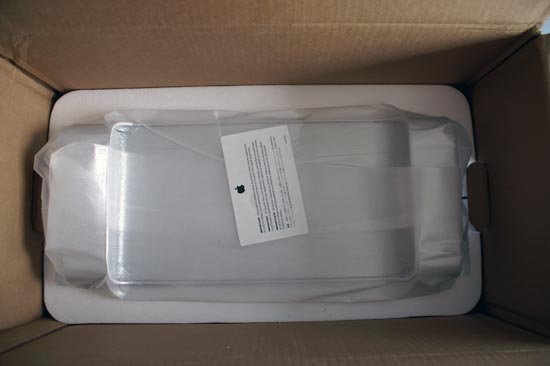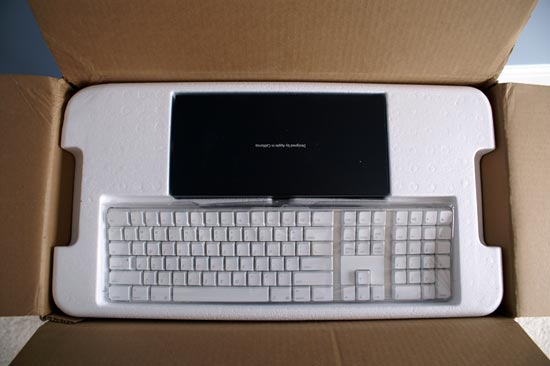Apple's Mac Pro - A True PowerMac Successor
by Anand Lal Shimpi on August 16, 2006 12:27 PM EST- Posted in
- Mac
It's here, it's quiet and it's fast; we got our Mac Pro on Friday and spent every day since taking it apart, using it and benchmarking it. There's far too much to include in one review, so we're breaking it up into three parts. We've already published the first part of our coverage last week, where we discussed the specifications of the new system as well as inadvertently turned the article into a primer on the implications of the FB-DIMMs that the Mac Pro uses. So if you want a brief two-page technical overview of FB-DIMMs, you'll want to consult that article.
Part two is what you're reading today; here we're going to be looking at the Mac Pro as a Mac (mostly) and compare the performance of two speed grades (2.0GHz and 2.66GHz) to the outgoing PowerMac G5. We'll also take the thing apart and give you a nice tour in pictures of the new chassis.

PowerMac G5 (left), Mac Pro box (guess where)
The third and final part will have two focuses - DIY upgrades (e.g. swapping CPUs and sticking in your own FB-DIMMs) as well as performance under Windows XP. Apple just released an updated version of Boot Camp with support for the Mac Pro that should hopefully address some of the serious performance issues we ran into while running Windows XP on our machine. Give us a week and you'll have part 3 to peruse at your leisure.
With our plan of attack laid out, it's time to dive into the Mac Pro and we'll start where very few Mac users like to: at its price. In the past we've generally shied away from getting too caught up in the price debate, because honestly if you're buying a Mac, you're doing so because of the OS and assigning value to that is difficult. Some users are content with other OSes and see no value in OS X, and to them the value in a Mac is simply the total cost of the components that make up the machine. At the same time there are other users who prefer OS X and thus find additional value in a system that is able to run that OS. Regardless of which camp you fall into, the Mac Pro is competitively priced. We'll let the table below do the talking:
|
Apple Mac Pro |
Dell Precision Workstation 490 |
Home Built Config |
|
|
CPU |
2 x Xeon 5150 (2.66GHz) |
2 x Xeon 5150 (2.66GHz) |
|
|
Memory |
2x 512MB DDR2-667 FB-DIMMs |
2x 512MB DDR2-667 FB-DIMMs |
|
|
Graphics |
GeForce 7300 GT |
Quadro NVS 285 |
|
|
Hard Drive |
250GB SATA 3Gbps |
250GB SATA 3Gbps |
|
|
Optical |
SuperDrive (DVD+R DL/DVD+-RW/CD-RW) |
16X DVD+-RW |
|
|
Notes |
Free 17" LCD, had to add sound card, mouse and 1394a card |
Includes Supermicro X7DAE motherboard priced at $474; does not include price of OS, case or power supply |
|
|
Price |
$2499 ($2299 with educational discount) |
$3110 |
$2390 |
The Dell is clearly more expensive, although you can knock off $100 - $200 thanks to the bundled LCD (unfortunately Dell gives you $0 credit if you remove the monitor from your order). We're able to come close with our own configuration by shopping at Newegg and other vendors through our shopping partner, but note that the $2390 total does not include an OS, case or power supply.

If you're in the market for a dual socket dual core Xeon workstation, Apple's Mac Pro is definitely a bargain. The only real issue here is that not everyone needs or can adequately use a dual socket Xeon workstation, in which case you can argue that there's better value in a cheaper single socket Core 2 system. Unfortunately Apple does not offer any such system, which leads us to believe that we'll either eventually see the introduction of a cheaper single socket Mac Pro or maybe even a new product line simply called the "Mac" that uses desktop Core 2 processors instead of their Xeon counterparts.
Bottom line? The default configuration of the Mac Pro is priced very competitively for what you get; whether or not you need what you get is a different discussion entirely.












96 Comments
View All Comments
spike spiegal - Thursday, August 17, 2006 - link
Question 1:Apple users have been bad mouthing Intel and PC's for over a decade and touting the superiority of Motorola, and then IBM over Intel. Now that Apple is running on nothing more than PC clone with an Apple bios and beating the heck out of the dual G5, isn't this a little hypocritical? When Apple switches to Cyrix next year, how much faster will those machine be over Intel?
Question 2:
If OSX so much more "secure", "faster" and "easier" to use than Windows or Linux, and OSX is closer to Unix than Liux is, why have I never encountered an Apple machine or OSX inside a corporate server farm? Are the graphics artists in the company media dept using Macs that much more intelligent than the network engineers who's job is on the line to keep commerce up 24/7?
Question 3:
A year from now when E-machine is selling boxes that cost half the price of the new PowerMac and has twice the horsepower because of new processors being introduce by either AMD or Intel, how can we fudge PowerMac benchmarks for the courtesy of Apple users?
Question 4:
I want to run OSX legally on my dual core AMD, and I don't want to buy a new computer just to run OSX. I can run Windows on any hardware I want...why not OSX?
plinden - Thursday, August 17, 2006 - link
Q1: Hmm, have you heard about the best tool for the job? G5s kept up well with Intel and AMD, and were often faster - sometimes much faster - but weren't going anywhere in the foreseeable future. Did you notice that that the new 2.66GHz Xeons aren't much faster than the 2.5GHz G5s they're replacing? But the potential is there for the future (the 3GHz Xeons show that). I don't know whether you're an AMD or Intel fanboi, but would you continue using a CPU from your current favourite manufacturer if you could foresee {AMD/Intel - delete as necessary} pulling well ahead? A computer is just a tool to get things done, what CPU is in there is a pointless argument, and your strawman argument just makes that all the more obvious.Q2. Hmm, have you heard about the best tool for the job? XServes are gaining some traction, especially in specialist areas, but I work a company that delivers streaming content on the internet, and we use (mostly) generic PCs running RedHat ES. We also have a number of Windows Media Servers for encoding wmv content and use Apple's Darwin QuickTime Streaming Server (running on Linux, incidentally). The fact that I actually enjoy doing my work with OS X, and find myself being more productive with desktop applications, doesn't mean that if I were making the buying decisions for my company, I would immediately insist on using XServes just because they're from Apple.
Q3: Cool, e-Machines are going to be producing 8-CPU Xeon-powered workstations for $1250? I might get a couple of those for the kids. Or maybe Apple might upgrade their offerings ... they've been known to do that occasionally.
Q4: Because Apple owns the rights to OS X, they make the decisions. If they offered OS X to run on any PC, I would be first in line to install it on my Dell laptop.
michael2k - Thursday, August 17, 2006 - link
1) At the time those comments were made, PPC was faster than Intel, literally. Then the IBM was faster than a P4, just like an Opteron was faster than a P4. You would be stupid to believe if Cyric made a faster, cheaper, cooler CPU that Apple wouldn't consider it.2) Why would a corporate SERVER FARM care about "secure", "faster", or "easier"? A SERVER FARM cares about redundancy, reliability, recovery, and distributed computing. The only places you will find a Mac are places that care about:
1) usability, say at a design firm
2) design, say at a advertising firm
3) ease, say at a home
Also, you do know that the pural for "anecdote" is not "data", right? Your anecdote only means you have limited experience.
3) Easy, drop in a new Intel processor.
4) Because no copy of OS X exists for generic x86 hardware. You also cannot run Windows on any hardware you want. Try to run it on an SGI MIPS workstation, an IBM PowerPC Workstation, a Dec Alpha workstation, or an Apple G4 iMac. This is despite the fact that Microsoft originally wrote Windows NT to support Alpha, MIPS, PowerPC, and Intel. You want to know why Apple won't produce generic OSes? Because they aren't big enough to afford the support and market costs. Until, I think, they hit 30% marketshare, they can't afford to sell their OS as a generic software kit.
saratoga - Thursday, August 17, 2006 - link
PPC was very rarely faster then x86. More often it was on par, but seldom faster, and usually only briefly. People went on and on about PPC performance because they had bought expensive PPC systems.Dubb - Thursday, August 17, 2006 - link
Really curious about those three:1) any issues with xp-64
2) We all know you have clovertons already. put them in and see what happens. then tell us.
3)Apple's price on a 4500 is way overpriced. there has to be a way to get a quadro 3500 working in one.
mgrimard - Thursday, August 17, 2006 - link
Since it is cheaper than a Dell, what about using as a server (with Windows Server 2003)?It is a server that it will most benefit from the quad-core and dual-gbe, don't you think?
Calin - Thursday, August 17, 2006 - link
"Of course if there's performance to be lost, we're there to benchmark it."That is very funny :)
And by the way, very nice article. Enjoyed every page of it. Thanks!
IntelUser2000 - Wednesday, August 16, 2006 - link
FB-DIMMs are not at complete fault here. It lies majorly in the memory controller. PC chipsets ALWAYS perform better than the workstation/server ones.
Calin - Thursday, August 17, 2006 - link
I find it strange that dual and quad channel FBDIMMs have the same memory read speed in Everest (or the difference is so small as not to be noticeable)dborod - Wednesday, August 16, 2006 - link
I understand the advantages of installing 4 FB-DIMMs vs. 2 FB-DIMMs and the need to install them in pairs, but does it matter if the first two pairs of FB-DIMMs are of difference sizes? In other words is 2 x 512 MB and 2 x 1 GB FB-DIMMs going to result is lower memory performance than 4 x 512 MB FB-DIMMs?